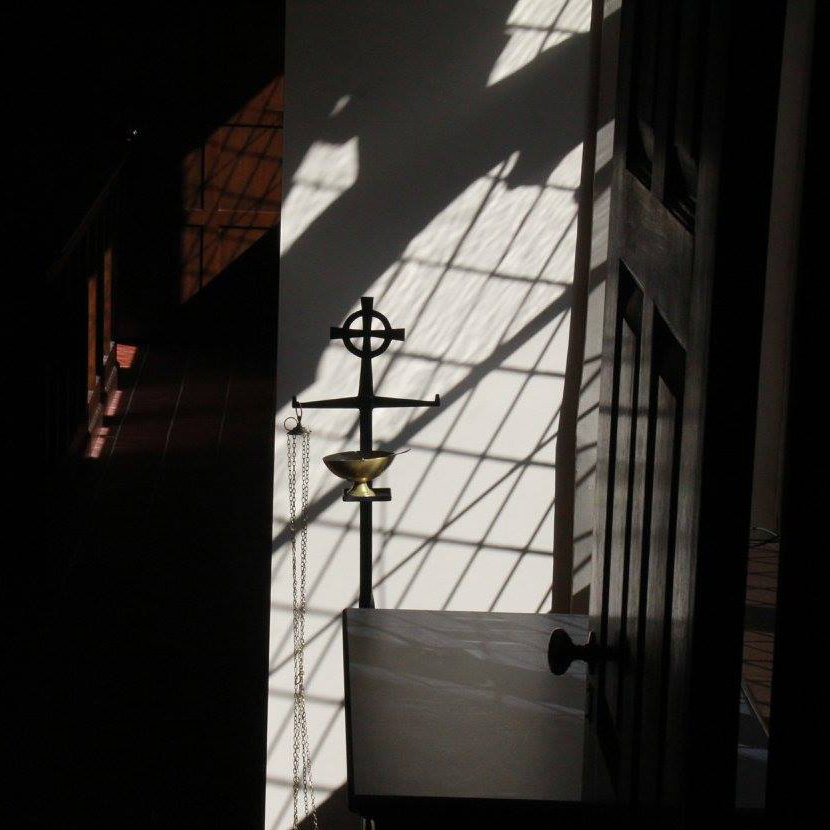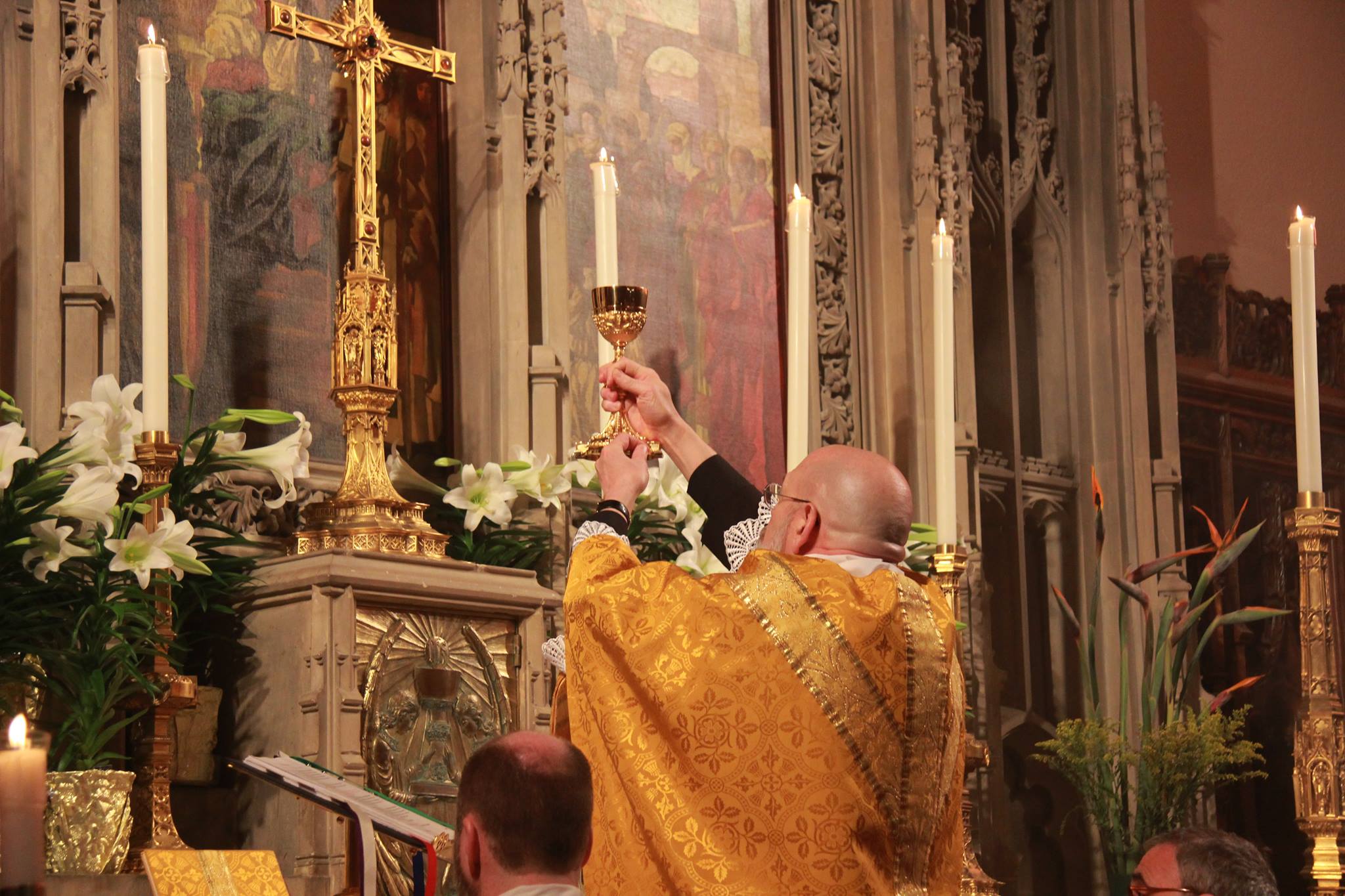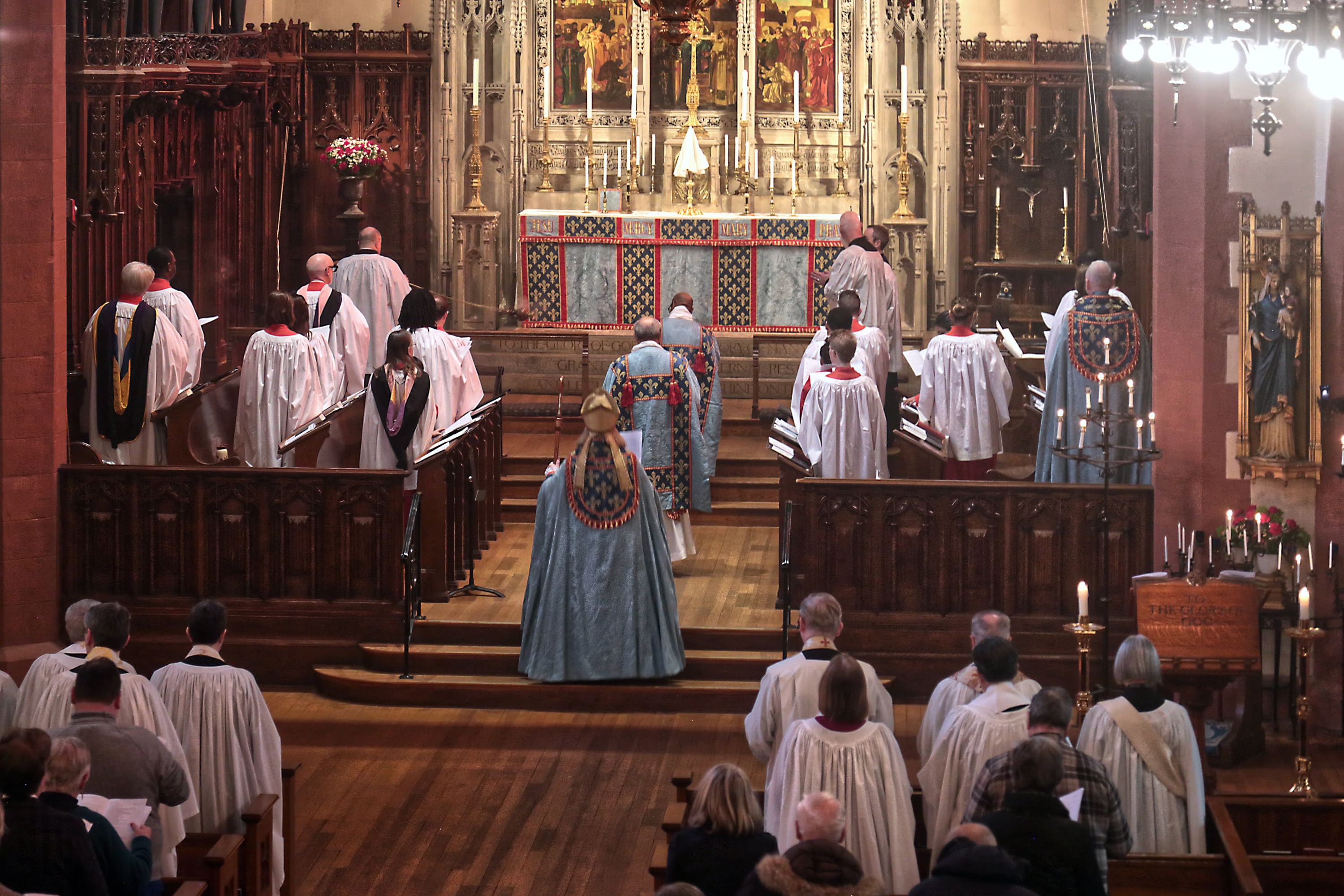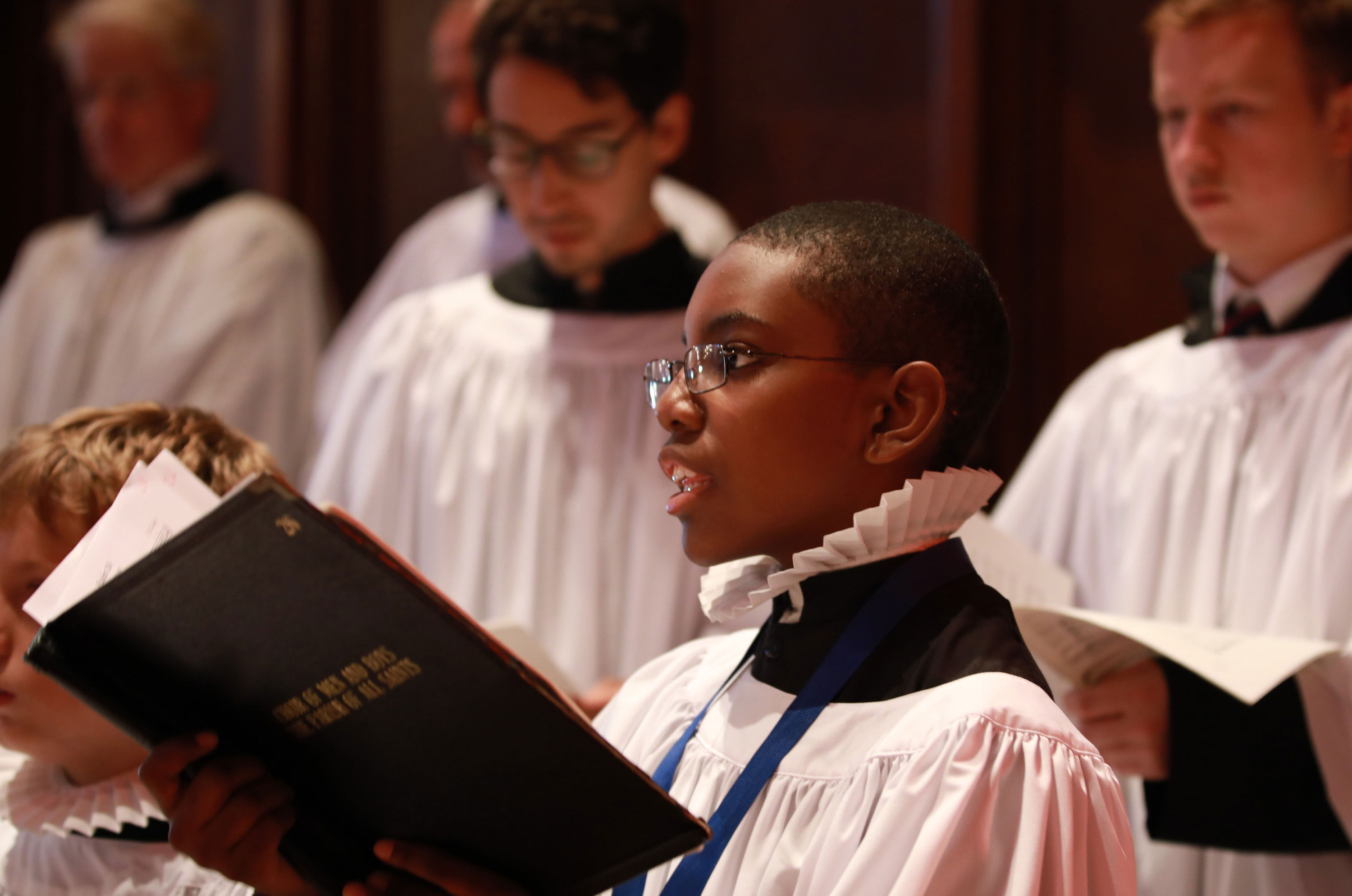My dear folk,
This Michaelmas marks the nineteenth anniversary of my installation as Rector. That’s rather a sobering reflection for me. It doesn’t seem all that long ago that Ruth and I were feverishly working to complete our move into the Rectory and get the house ready for the institution guests. Indeed, Fr. Mead and Nancy arrived at the house as I was on the third floor replacing a broken light socket in a bedroom sconce. Yet on the other hand, I must confess that I begin to feel as though I have been here indefinitely as year follows year..
{grid8}It’s rather like asking Ruth about some experience we’d shared in the long past, only to realize that we wouldn’t even have met at that time. While I’d like to think that this dynamic shows that I’ve finally mastered the art of “living in the present moment” I’m afraid that forgetfulness may be the more convincing explanation. But back to my point: coming to All Saints’ has been one of the greatest joys of my life. I continue to give God thanks for this blessing and to rejoice in your fellowship in the midst of this earthly pilgrimage.
As we start a new program year, I though I’d take the opportunity to bring you all up to date on several things in our parish life.
It is a delight to have Andrew Sheranian back from his sabbatical. During his time away he had the opportunity to observe rehearsals and services of some of the finest men and boy choirs in England, including St. John’s College in Cambridge, King’s College in Cambridge, St. Alban’s Abbey, Rochester Cathedral, Temple Church in London, as well as Westminster Abbey. It is, of course, this tradition which we hope to emulate in our parish setting. Later, he was able to hear a number of significant organs in Germany, including a visit to St. Thomas Church, Leipzig, where Bach served. In the midst of that sabbatical time he returned to take a number of our trebles to Massachusetts (formerly Montreal) Boy Choir Course for the last week in July, culminating in two glorious choral services at Trinity Church, Copley Square. He then led our own treble choir camp in Essex, New York, in August. He also performed concerts at the University of Utah and on the Great Organ in the Methuen Memorial Music Hall. And, of course, he was here to play and conduct the choir for our Assumption Mass. It was a full and rewarding time. And as a parish we look forward to enjoying the fruits of his growth as a musician and from the insights gained from his exposure to these most excellent choirs and instruments.
We owe a great debt of gratitude to Michael Raleigh (our former Davison Fellow, now Associate Conductor) who led the choir through the end of the choral season, as well as Daryl Bichel and Lee Ridgway who played the services and accompanied the choir, and then provided musical leadership for our services through the summer. How fortunate we were to have such fine musicians able and willing to step in and provide for the continuing needs of the parish! That there are long-standing relationships with each was icing on the cake.
The other matter I want to address is, of course, the Building Restoration project. There are times when I begin to feel that this topic could well take the title from a children’s book: The Neverending Story. Many are surprised to hear that the project has not been completed yet. After all, the building no longer looks like it’s under construction, and we’ve even had a special service – two years ago at that – to celebrate the restoration. The truth of the matter is that while most of the work has been completed for several years, we still are working at the punch list. This was a massive project; it is not surprising that there was a substantial punch list, items not yet completed or which have been discovered to need further work or correction. But quite frankly, the completion of the punch list has taken far, far longer than it should have (possibly exacerbated by the boom in the construction business which Boston has experienced). So while on the surface it may have appeared that the project was wrapped up, there nevertheless has been a lot of effort expended behind the scenes. Monitoring systems, inspecting for problems, documenting issues were all the more important since the construction managers and contractors have not been on site regularly as they were prior to demobilization in January 2015. The good news is that the punch list is, for all intents and purposes, completed with the exception of two major areas: water intrusion and the heating system.
We have experienced a number of leaks, mainly in the tower, the Lady Chapel, and the St. Mary’s aisle. Since these roofs were completely replaced, along with the flashing, gutters, and downspouts, this has been disappointing and puzzling. Water leaks are also notoriously hard to locate, for the water can enter the building at one point and then travel some distance before it passes out of the wall or ceiling; it’s not simply a matter of looking directly above the puddle on the floor. Wind intensity and direction also have a large role in water intrusion. A particular leak may only appear in a gusty northeaster, and be sound and dry through heavy downpours or if the wind is from the west. Interestingly, water leaks were a problem even when the building was first built. In our archives I came across an issue of The Chronicle from around 1904. Fr. Whittemore wrote of some work about to be done which was hoped would bring an end to the leaks which had plagued the building from its construction. Let me just say that this is one area in which I do not want to continue an All Saints’ tradition.
Significant work has been done on the heating system this past year. Over a year ago a new HVAC subcontractor was brought onto the job. Five radiators in the Parish House were replaced: those originally installed were smaller than what was called for in design, and therefore provided less heat than needed. That, and the lack of the specified balancing valves, resulted in Peabody Hall and the Guild Hall being difficult to get up to temperature. There just wasn’t enough heating capacity in the room. Those new radiators were installed last fall; the difference was remarkable. We also experienced unacceptable levels of noise from two of the three air handler units for the chancel, nave, and Lady Chapel. Heat in those conjoined areas is provided from the basement level by means of ducts passing through the floor in the aisles and the wall of the Lady Chapel. Air is heated by hot water radiators in the air handler units and then forced by fans into the church. The noise from these two units was so distracting that we would turn them off during services. Last fall the duct work for the chancel air handler was altered and a silencer was installed. Unfortunately, the problem with the air handler for the Lady Chapel could not be dealt with in the same way. After considering various possibilities and the very tight space available around the unit, our acoustical consultants came up with a solution: incorporating in the ductwork a plenum (a large metal box, lined with acoustical padding, with a duct bringing in the heated air and another duct on the other side directing it to the room). That work has now been completed and the noise from these two units has now been reduced to acceptable levels. Finally, there are some areas in the computerized controls for the heating system which need work, but the work on the hardware (boilers, pipes, valves, etc.) needs to be completed before addressing problems arising from software.
When these issues are resolved, we will be able to proceed to the remaining inspections, receive our new occupancy permit, and have the final close-out of the project. This is a consummation devoutly to be wished. Your building committee will no doubt entreat the Choir for a Solemn Te Deum in thanksgiving when the last inspection is completed, all the accounting settled, and the final reports are sent to the generous and patient foundations which have been our benefactors.
In addition to the restoration project itself, there are several other building-related matters to be noted. The beautiful black and white marble floor in the St. Stephen’s Chapel was restored in the Spring. Some scratches and stains which occurred during the restoration work were removed. We took off multiple layers of floor polish (which should not be used on marble). The floor was then honed and polished. The result is wonderful; if you’ve not seen it, I urge you to take a look. St. Stephen’s Chapel is an artistic treasure. I first saw St. Stephen’s Chapel when Ruth and I worshipped here in the late 1980's, while I was on vacation from my parish in Vermont. How well I remember being stunned by its beauty as I caught a glimpse while returning to our pew after receiving the Sacrament. I still feel that stab of wonder and joy each time I approach that altar to celebrate the Holy Mysteries.
During the building restoration, we were not able to sand and refinish the floor in the choir room. This was a matter of balancing our many needs with the realities of our budget. The choir room was also a distinct area which could be easily addressed by itself at a later time. This summer we were able to do just that. The result is beautiful to see and protects the original floor in this heavily used space. While on site, the flooring contractor also made repairs to a number of floorboards in the church and the cloister which were loose or damaged (you may have noticed pieces of blue painters tape marking those spots until our job could be fitted into their schedule).
Finally, many have mentioned to me the lack of a church sign. Our old metal sign was removed during the restoration; the temporary plywood sandwich sign was more than due to be retired. Although originally part of the restoration project, difficulties in finding a fabricator for the new sign led to it being dropped from the project. We now have found a craftsman whose work is of the quality we desire. The design has been refined and is at the point for final approval. We hope to move forward with fabrication and installation as soon as it is possible for him to do this work.
Yours, in his service,
Michael J. Godderz+
{/grid8}{grid4_last}

(Ruth Godderz)
{/grid4_last}





